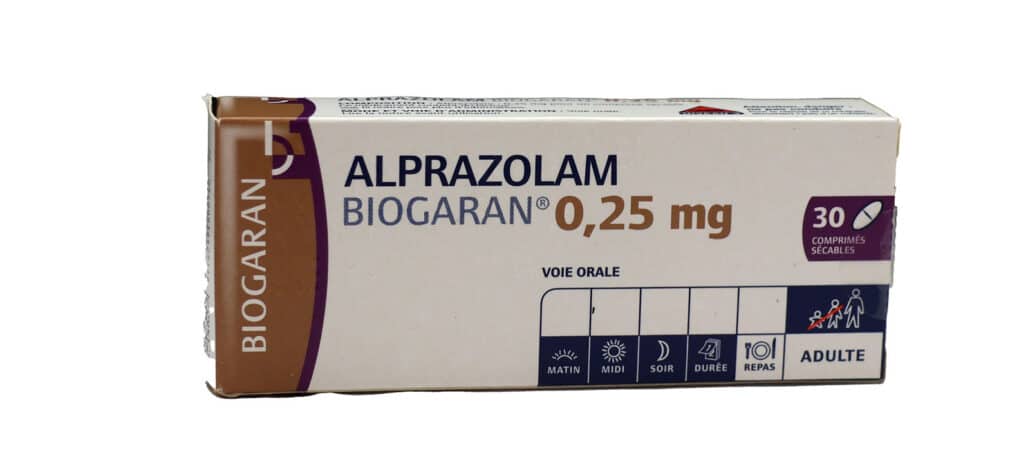Alprazolam, popularly known by its brand name, Xanax, is one of the most widely prescribed medications in the United States, with millions of prescriptions being written each year. This drug is well-recognized for its quick-acting and calming effects.
Although effective, taking alprazolam can also lead to misuse, abuse, and addiction, with a great risk of dangerous and life-threatening side effects. As such, healthcare professionals, employers, and law enforcement officers may include it in their drug screening tests.
The detection time for alprazolam in standard urine tests is 4 to 7 days after the last dose. This guide will cover factors affecting how long this medication stays in the body, and general information about alprazolam, its side effects, addiction treatment options, and more.
Table of Contents
- 1 What Is Alprazolam?
- 2 How Does Alprazolam Work?
- 3 How Long Does Alprazolam Stay In Your System?
- 4 Table: Alprazolam Detection Times
- 5 Factors That Affect How Long Alprazolam Stays in Your System
- 6 Common Side Effects of Alprazolam (Xanax)
- 7 Signs and Symptoms of Alprazolam (Xanax) Addiction
- 8 Treatment Options for Alprazolam (Xanax) Addiction
- 9 Get Help for Alprazolam (Xanax) Addiction Today
What Is Alprazolam?
Alprazolam (Xanax) is a commonly prescribed medication used to treat generalized anxiety disorder and panic disorder, with or without agoraphobia.

It belongs to a class of drugs called benzodiazepines, which make the nervous system less active and slow down the brain and body’s functions. It may also be prescribed for insomnia, depression, and premenstrual syndrome, but these are non-FDA-approved or off-label uses.
Alprazolam is a Schedule IV controlled substance, defined as a drug with a low potential for abuse and a low risk of dependence. However, since it provides rapid but temporary relief, as well as a euphoric and relaxing sensation, this medication can become addictive.
How Does Alprazolam Work?
When a person takes alprazolam (Xanax), the drug acts on the Gamma-Aminobutyric Acid (GABA) receptors in the body. GABA is an inhibitory neurotransmitter. It’s a brain chemical that slows down nerve impulses in the central nervous system, producing a calming effect.
This effect helps people relax and reduces their anxiety. Alprazolam is fast-acting, and its effects can be felt within 30 minutes of taking it. For some people, it acts as quickly as 5 to 10 minutes.
It takes around 1 to 2 hours for alprazolam to reach its peak concentration in the body. After this, the body starts breaking down and eliminating it, and its effects gradually decrease.
How Long Does Alprazolam Stay In Your System?
To understand how long a substance stays in your system, it’s important to consider its half-life, which is the amount of time it takes a healthy adult body to process and eliminate half a dose of the drug. The half-life of Xanax (Alprazolam) is 11.2 hours for 50% of the drug to be removed.
It generally takes 4 to 5 half-lives to eliminate 97% of a drug from your body. This means that alprazolam can stay in your system for 2.33 days before being cleared out entirely. Note that it can still appear on drug tests after this time, as they detect a drug’s breakdown products as well.
Immediate-Release vs. Extended-Release Alprazolam (Xanax)
Alprazolam (Xanax) is available in various forms and dosages, including tablets and oral solutions. Xanax tablets are immediate release, meaning all of the medication is released as the tablet dissolves, and they are quickly absorbed by the body, taking effect in a few hours.
There’s also an extended-release version of the tablet (Xanax XR), which releases the medication slowly, over an extended time. These formulations can last much longer in your system and have a longer half-life compared to immediate-release tablets.

How Long Does Alprazolam Stay In Your Urine?
A urine test is one of the most common methods of testing for drug use, as substances are normally filtered out by the kidneys and leave the body through urine.
Most urine drug screens will be able to detect alprazolam. The detection time is 4 to 7 days after the last dose, depending on the dosage and frequency of use.
Heavy or chronic users are likely to have the drug in their urine for a longer amount of time—up to one week. However, for occasional users, the detection window can be as short as 4 days.
How Long Does Alprazolam Stay In Your Blood?
Blood tests can detect whether a person has taken alprazolam within the last 24 hours. They’re typically used during medical emergencies, such as car accidents, to help law enforcement and healthcare professionals identify if someone is currently experiencing the effects of the drug.
This type of drug testing is less common, more invasive, and more expensive than others. However, the results are accurate and usually available right after performing the test.
How Long Does Alprazolam Stay In Your Hair?
Hair tests can detect alprazolam for the longest length of time, up to 90 days after the last dose. This type of test is effective in determining a person’s long-term drug patterns, but it’s seldom used as most tests are intended to detect recent consumption.
Traces of alprazolam accumulate in a person’s hair follicles, but it can take much longer for the drug to appear in hair compared to bodily fluids. If a half-inch hair sample is taken too soon after someone uses the drug, the test might come back negative.
How Long Does Alprazolam Stay In Your Saliva?
A saliva test has a shorter detection window. It can detect alprazolam in your saliva within 2.5 days after use. This method of testing is less common than urine tests, but it’s also regarded as the less invasive option between the two.
Table: Alprazolam Detection Times
Alprazolam, commonly known by the brand name Xanax, is a benzodiazepine used to treat anxiety and panic disorders. The detection window for alprazolam varies depending on the type of test administered. Below is a summary of the approximate detection times:
| Test Type | Detection Window | Notes |
|---|---|---|
| Urine | Up to 4 days; up to a week for heavy users | Alprazolam and its metabolites can be detected in urine for up to 4 days after use, with longer detection times in heavy users. |
| Blood | Up to 1 day | Blood tests can detect alprazolam for up to 24 hours post-ingestion. |
| Saliva | Up to 2.5 days | Alprazolam is detectable in saliva for up to 2.5 days after use. |
| Hair | Up to 1 month | Hair tests can detect alprazolam for up to a month after the last dose. |
Please note that these detection windows are approximate and can vary based on individual factors such as metabolism, frequency of use, dosage, and overall health.
Factors That Affect How Long Alprazolam Stays in Your System
The length of time alprazolam (Xanax) stays in your system depends on a variety of factors, including the amount of drug taken, and the frequency and duration of use. Regular and long-term use can cause the drug to accumulate in the body, and take longer to be eliminated.
Your age and the speed of your metabolism matter as well. Younger people process substances faster, meaning alprazolam can clear out of their bodies quicker than most older adults.
Since the liver and kidney play a major role in filtering and eliminating the drug, any diseases or impaired functioning of these organs can make alprazolam stay in the body longer.
Body composition is also an important factor to consider. Alprazolam is fat-soluble, which means it’s absorbed by adipose tissue or fat. People with obesity or a higher body fat percentage can have a prolonged drug presence than someone who has a normal weight.
Other factors that can influence how long alprazolam stays in your system include a person’s medical history, genetics, gender, ethnicity, and the presence of other drugs in their body.
Common Side Effects of Alprazolam (Xanax)
Alprazolam use can result in mild, moderate, or serious and life-threatening side effects, which can manifest physically, mentally, or both. Here are some of its most common side effects:
- Sleepiness
- Dizziness or nausea
- Memory loss
- Difficulty in concentrating
- Trouble speaking clearly
- Low blood pressure
- Irritability
- Dry mouth
- Stuffy nose
- Headaches
- Constipation or diarrhea
- Changes in mood, appetite, or weight
Many of the side effects of taking alprazolam resemble those of consuming too much alcohol. People can become confused, slow to react, or have issues maintaining their balance, which can affect their ability to drive safely and increase their risk of falls and accidents.
If you or a loved one is experiencing the side effects of this medication, talk with your doctor or contact your local emergency number as soon as possible.
Signs and Symptoms of Alprazolam (Xanax) Addiction
Because of its short-acting and intense effects, alprazolam can become habit-forming and has the potential for misuse and addiction. Even people who take the medication as prescribed by a doctor can develop an addiction, especially if they think they cannot handle daily life without it.
It’s possible for users to quickly build a tolerance to alprazolam, leading to more frequent and heavier dosages. A person addicted to the drug will show various symptoms, including:
- Loss of motivation and interest in normal activities
- Increase in thrill-seeking and risk-taking behavior
- Strained relationships with family and friends
- Financial and legal problems
- Withdrawal symptoms and strong cravings for the drug
- Issues with mood, memory, and concentration
- Needing more of the drug to feel the same effects as before
Treatment Options for Alprazolam (Xanax) Addiction
There are a variety of treatment methods for alprazolam (Xanax) addiction. The process usually begins with an assessment from a qualified healthcare professional, who will consider the patient’s medical and personal history in creating an effective, individualized treatment plan.
Addiction treatment may involve one or a combination of the following:
- Medically supervised detox
- Inpatient or residential treatment
- Outpatient treatment
- Addiction counseling
- Individual, couples, or family therapy
- 12-step programs and peer support groups
Continued support and guidance from family and friends, as well as a positive and healthy environment, are also necessary for an individual’s long-term recovery.
Get Help for Alprazolam (Xanax) Addiction Today
Alprazolam (Xanax) can be incredibly helpful in treating conditions like anxiety and panic disorder. However, this medication is prone to misuse, which can eventually result in addiction.
If you or a loved one is struggling with alprazolam addiction, it’s best to speak with a doctor as soon as possible and seek help from a qualified treatment center, like Long Island Interventions.
Our caring and compassionate team of expert addiction specialists will guide you to a safe and effective recovery using our evidence-based treatment plans. It’s never too late to begin your recovery journey, so contact us today or visit our contact us page to learn more.
Published on: 2024-09-23
Updated on: 2025-04-26

